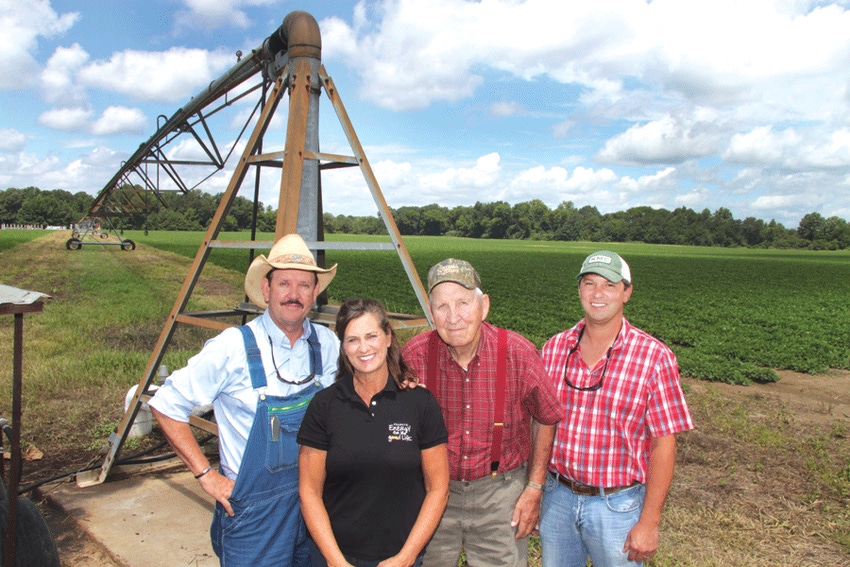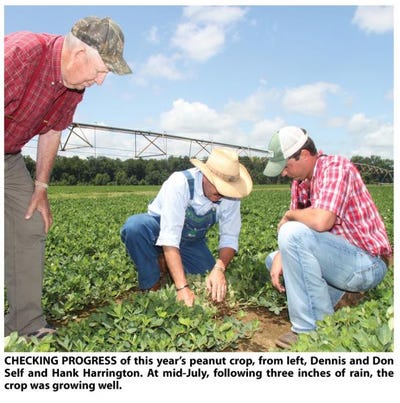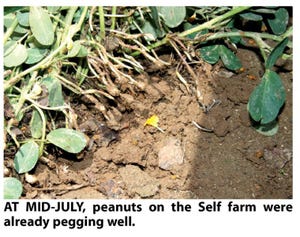
“We’re all peanuts this year,” says Hamilton, Miss., producer Don Self, who is also Mississippi's representative on the National Peanut Board. “Even though we rotate religiously between cotton, corn, and peanuts, the $750 per ton contract price at the start of the season was just too good not to take advantage of this year."

For years, says Don Self, “My father and I just grew cotton and soybeans, with a little corn occasionally. But when we started growing peanuts, rotation became a necessity in order to limit diseases, and we dropped soybeans.
“Even though soybean prices have been attractive in recent years, we don’t want them in rotation with peanuts, because they have some of the same diseases,” says Self, who now farms with his father Dennis, son Nathan, and son-in-law Hank Harrington at Hamilton, Miss., and is Mississippi’s representative on the 11-member National Peanut Board. “We adopted a one-third cotton/corn/peanut rotation that we stick to religiously.”
Except for this year.
“We’re all peanuts,” he says. “The $750 per ton contract price at the start of the season was just too good not to take advantage of.
“With the big price runup to $1,000 in 2011 due to the crop shortage nationwide, a lot of people were holding out this year for $900 or even $1,000 — kinda like holding out for $1.50 cotton a couple of years ago. But I told the Birdsong Peanuts people, ‘We’ll take all we can get at $750; in fact [he laughs], I’ll contract years ahead for $750.’
“Trying to get the top price for any crop is just a shot in the dark; nowadays, a farmer has to maximize every dollar. If I can see a good profit, I’ll take the sure thing any day over trying to hold out for an extra dollar that may never materialize.”
Next year, he says, “We’ll go back to our rotation program.
Blog: When down becomes up: How 379 acres of peanuts got confused
“When I’m talking with new growers, I tell them I can’t emphasize enough the importance of rotation — not just for disease/weed control, but for the benefits that each crop provides for the others.”
Although the Selfs have only been growing peanuts since 2007, they’re among the pioneers of the crop in northeast Mississippi.
“In 2005, Dan West, who farms here in Monroe County, was the first to grow peanuts for Golden Peanuts,” Don says. “The Atkins family, William Dean, Allen, and Brian, also here in Monroe County, were second, and in 2007 we were third.
When the first peanuts went in and additional growers were being sought, Don began an intensive study of the crop. “I studied peanuts night and day, read everything I could get my hands on, talked to every grower and every specialist who would give me time,”
“A lot of what I knew from my years of growing cotton, soybeans, and corn I had to throw out the window. Planting depth, for example — I’d never before planted any crop 2½ to 3 inches deep. There was a real mental adjustment. And every year we grow the crop, I learn something new.
“After all my studying, I told Daddy, who’d grown cotton all his life, that if we could survive the learning curve for growing peanuts, I believed they could be a profitable crop.”
“Ever since then when a problem would come up — particularly in 2009, when we got 35 inches of rain from Oct. 1 through Dec. 15 — Daddy would ask me, ‘How long is this learning curve going to last?’
“For a lot of Mississippi farmers,” Don says, “2009 is the bad year to which they’ll compare all future bad years. We’ve never had one that bad, and I hope we never see another like it.
“We had 80 acres of quality peanuts on top of the ground and we could never get a combine in the field to harvest them. It was sickening. But the deer had a great feast all winter long — they love peanuts! — and in the spring we plowed under what was left.”
In meetings where he speaks, particularly to new growers, Don likes to say, “Peanuts are a tough crop, and they can be very forgiving.”
But he then adds a cautionary note: “There are a lot of things that can go wrong — and if you think you’re just going to plant them, then wait to dig them and collect your money, you can be in for a rude awakening.”
Irrigation becoming a necessity
To further boost production potential on their farm, particularly for corn, Don says, “Our goal is to have 75 percent of our crop land irrigated within the next five years. With our changing weather, it has become apparent that irrigation is going to be a necessity for consistent crop production, particularly with corn.
“We have two center pivots now that can water 180 acres, and we’re going to build a big lake in a low-lying area to provide additional water for irrigation. We’ll add more center pivots, and probably less than 20 percent of the irrigated land will be furrow.”
They’re also in the process of converting some of their timber acreage to cropland. “We’ve just cut about 120 acres of mostly hardwoods, and we’re clearing some other areas that should give us another 200 or so acres. That will put us at a level that we have about as much acreage as we can handle without more labor.”
Feature: On Taylor farm in Arkansas, peanuts add diversity and rotation benefits
Read: Bumper peanut crop dampens markets
They grow GA 06G peanuts, “which is a good variety,” Don says. “In the past, we’ve grown some GA 07W, and some AT 215, a 115-120 day peanut that’s good for late planting or behind wheat. GA 09B is looking promising in trials, and I’m anxious to see this year’s data on it.”
They started planting May 2 and finished May 27, but had to replant 379 acres due to a weather phenomenon during germination that caused the peanuts to start growing the reverse of normal (see article, "When down becomes up: How 379 acres of peanuts got confused").
At mid-July, following 3 inches of rain, Don says all the peanuts were looking good.
“The 95 to 100-plus temperatures we had in late June/early July are hard on peanuts, but the rains since then have been great. If we can just get a couple of more good rains going through the season, we should have a good crop.
“Because peanuts are relatively new in this area, as a general rule we don’t have the disease pressures that they have in south Mississippi, or in the southeastern states, where they’ve grown peanuts for years and can make eight or more fungicide applications in a season.
“We made our first application of Provost fungicide in July. We may have to make one or two more, depending on the rains we get. We could have a touch of white mold here and there, but so far we’ve been able to control it.
“We’ve had a bit of leaf scorch from the very hot weather earlier, but the rains and more moderate temperatures seem to have taken care of that. We’ve had a few cutworms, but nothing that we’ve needed to spray — if we do, Ammo takes care of them. Three or four years ago, we had to spray for some three-cornered alfalfahoppers, and we’ll have occasional armyworms, but usually not enough to warrant spraying.
“Peanuts need boron, and we apply Solubor at 3 lbs. per acre when we apply the fungicide.”
This year, Don says, they deep-tilled all their land to 10-12 inches with a five-bottom switch plow. “Over the years, with cotton and soybeans, we’d moved away from deep tillage, but in our present rotation, I believe it helps with diseases and weeds by turning under old cornstalks and debris. It has also made the ground more mellow, which makes it easier for peanuts to peg into the soil.
“Our plan is to deep-till one-third of our acreage every year. We think the benefits will outweigh the fuel and other costs.”
Thus far, he says, they’ve had no resistant weeds on their land. “We run a very tight weed control program, and we’re on the lookout for any escapes; we don’t leave any weeds in the field to go to seed. We also make sure that any equipment that comes on our farm has been properly sanitized; I think a lot of weed problems start from seed brought in on equipment.
Weed control program
“With our conventional tillage program, we don’t do any burn down. We disk, do-all, run a hipper-roller, and plant. We apply Prowl H20 and Valor behind the planter, and in certain areas add Strongarm at the one-half rate for red root pigweed and Palmer amaranth. Later, we’ll apply a Blazer, 2,4-DB, Basagran tank mix, or Cadre plus2,4-DB. We also apply 16 oz. of Volunteer, which gives us excellent grass control.
“Our consultant, Mitt Wardlaw, Southern Ag Consulting at Starkville, Miss., whose advice we trust implicitly, says if you have to have a limiting factor with peanuts, it should be something you can’t control, like weather. So, we work hard to make sure none of the things we can control are limiting factors.”
In a perfect world, based on this year’s planting dates, “We should be able to start digging about Sept. 23, which would be the earliest ever for us,” Don says. “Last year, we started digging exactly 135 days after planting, which was a first for us. If there are no weather setbacks, we can be done with harvest in 30 days — and be getting ready for deer season.”
They have two 6-row combines, an Amadas self-propelled combine and a KMC pull-behind, plus two KMC 4-row diggers.
Mississippi growers have done well with peanuts, he notes; last year, the state had the nation’s highest average yield. “We had the best crop ever on our farm,” Don says. “We had some fields that yielded 6,000 pounds-plus, and our average across all fields was 4,664 pounds. For us, that was phenomenal.”
Feature: Peanuts in Mississippi – it’s not just the good prices
Don’s grandfather started farming here and his father continued the tradition.
“My earliest childhood memory is of playing in a cotton wagon on Daddy’s farm,” he says. “He’s 78now, but he’s still a hands-on guy; he knows everything that goes on. He still helps with planting and harvesting, and he’s really sharp at marketing cottonseed at Farmers Gin, the co-op in which we’re shareholders, and he serves as board president. My mom, Mary Anna, keeps books for the gin, which ginned 40,000-plus bales last year. And my wife, Lisa, runs the seed tender and module builder, and has been a vital part of everything we’ve achieved over the years.
“Our son-in-law, Hank Harrington, had a good off-farm desk job, but like me, he’s an outside kind of guy, and I couldn’t be happier that he decided to join us on the farm. He’s very talented and can do anything that needs to be done.
“Our son, Nathan, has a good off-farm position with a nearby industry, but he takes vacation time to help out here when we’re in a crunch at planting and harvesting, and I’m hoping I can eventually persuade him to come back to the farm.”
Don says he’s grateful to “so many people who helped us when we started growing peanuts — Dan West and the Atkins family, who pioneered peanuts in this area; Dr. Marshall Lamb, research director at the USDA National Peanut Research Laboratory; Dr. John Beasley, peanut specialist at the University of Georgia; Mike Howell, Mississippi State University Extension peanut specialist; Joe Morgan, long-time grower at Hattiesburg and president of Mississippi Peanut Growers; the Birdsong Peanuts staff — everyone was so good to us, so helpful.
“Helpfulness is catching, and I made a commitment that I would do the same, that I’d help any grower I could with advice and the benefit of my experience with the crop. You can face some real hardships with peanuts, and if I can be of assistance to another grower, that’s what I want to do.”
Peanut Board programs
He’s especially complimentary of the National Peanut Board, its members, and staff.
“It was a great honor when the Secretary of Agriculture telephoned to tell me I’d been appointed to represent Mississippi. I’m now in my fourth year on the board, and I never cease to be amazed at how effectively producer contributions, ranging from $6 million to $8 million per year, are being used.
“The NPB board members are some of the most knowledgeable, most astute people about peanuts and agriculture in general that I’ve ever known. Board President Marie Fenn, in the Atlanta headquarters, does a wonderful job of running the organization and stretching a relatively small annual budget to get the maximum good for the industry through its research and promotion programs. Everyone on the board and staff takes the American peanut farmer and his financial contributions very seriously, and I’m proud to be a part of such an outstanding group.”
And Don says, his board duties have provided broader opportunities to spread the message about agriculture and its contributions to the nation’s food security and the environment.
“I’ve had the good fortune to travel a lot in my Peanut Board work. Recently, I was standing on a street corner in New York City, surrounded by people who likely never give a thought to the agriculture that sustains them. If there were to be a major interruption in the food supply chain, I thought, how long would it take for there to be anarchy among 16 million people with no access to the bounty they take for granted every day?”
“And any number of times, I’ve had people quiz me about the chemicals we use and lecture me about the harm farmers are doing to the land and water. I tell them, ‘I live on the land that I farm, my family and my parents and my grandchildren live there, too. We eat vegetables from the garden, fish from the ponds, and drink water from the wells — do you think I’d be doing anything that would harm the people I love the most, or the land that goes back to my grandfather — just so I could sell you something?’ The response I usually get is, ‘I never thought of it that way.’”
Don says, “I’m not a farmer because I farm — I’m a farmer because that’s what God made me. I was blessed to grow up on a farm, with loving parents who taught by example. Lisa and I have been blessed to raise three fine children here, and now we’re blessed to have four grandchildren growing up on the farm.
“There’s no better place to raise a child than on the farm. Every day they see God’s handiwork firsthand, and they learn so many lessons that will be valuable to them throughout their lives. It’s hard to put a price on that.”
About the Author(s)
You May Also Like



